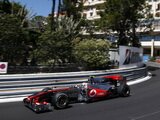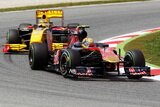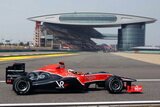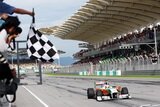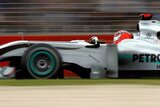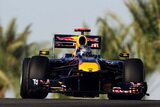“With four years of regulation stability, we have a good basis to be progressive about the development of this seasons car,” explained Michael. “With a good reliability record last year, we have been able to build on this quality while also turning some of our attention to clear performance objectives.”
Besides the settled regulations governing aerodynamics, the squad have also benefited from their established technical team and continuing relationship with engine supplier Toyota. Consequently, the new car retains much of the structural and layout philosophy of its predecessor, featuring the same zero keel and dual pillar rear wing.
Thats not to say that nothing has changed on the new car and there are several visible alterations. These include the introduction of a three-plane front wing, larger sidepod top cooling louvres as a result of the altered orientation of the water radiators, the sidepod and side-impact sails, and increased cockpit sides in compliance with new driver safety requirements.
“Our focus has been on performance as well as refining our packaging and weight distribution,” added Michael. “We are designing a tidier car with a higher standard of build quality. The FW30 should represent a good step forward when all of the many small areas of attention and improvement are brought together in the overall package.”
Prior to the cars debut, the team also focused on adapting the car in readiness for the introduction of the standard ECU and the prohibition of traction control. Time has also been spent on a new seamless-shift gearbox and on woking with fuel partner Petrobras on making the FW30 bio fuel compliant.
Following Mondays shakedown in the capable hands of tester Hulkenberg, the British squads race drivers Nico Rosberg and Kazuki Nakajima will get behind the wheel of the new car on Tuesday.
Williams FW30 technical specification:
Chassis construction - Monocoque construction fabricated from carbon aramid epoxy and honeycomb composite structure, surpassing FIA impact and strength requirements
Front suspension - Carbon fibre double wishbone arrangement, with composite toelink and pushrod activated torsion springs
Rear suspension - Double wishbone and pushrod activated torsion springs and rockers
Transmission - WilliamsF1 seven speed seamless sequential semi-automatic shift plus reverse gear in a aluminium maincase, gear selection electrohydraulically actuated
Clutch - AP Carbon plate
Dampers - WilliamsF1
Wheels - RAYS forged magnesium
Tyres - Bridgestone Potenza, F 350mm wide, R 375mm wide
Brake system - 6 piston AP calipers all round, Carbon Industrie carbon discs and pads
Steering - WilliamsF1 power assisted rack and pinion
Fuel system - ATL Kevlar-reinforced rubber bladder
Electronic systems - MES
Fuel - Fuel by Petrobras
Cooling system - Marston oil, water, and gearbox radiators
Cockpit - Driver six point safety harness with 75mm shoulder straps & HANS system, removable anatomically formed carbon fibre seat covered in Alcantara. Safety Devices extinguisher systems
Motive Power - Toyota 2.4L V8, 900 V angle, pneumatic valve train. Fuel management and ignition systems by Toyota spark plugs by ND. Engine materials include block and pistons in aluminium, crankshaft in steel billet, connecting rods in titanium
Dimensions and weight -
Weight - 605kg with driver, camera and ballast
Wheelbase: 3100mm
Overall length: 4500mm
Overall height: 950mm
Overall width: 1800mm
formula1.com
Comments:


